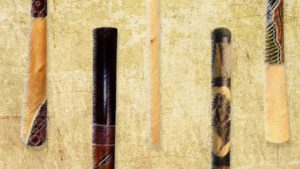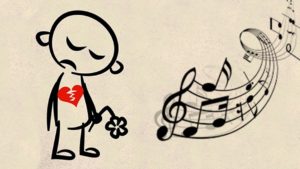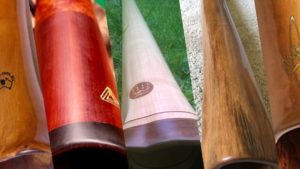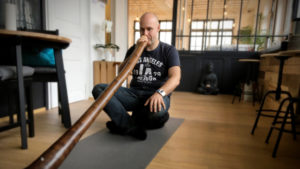By the way, I’m using this article to convey part of the way I see the didgeridoo and music. Being self-taught and not having had any formal musical training, I can provide my perspective without being restrained by current academic thought. Admittedly, I run the risk of sounding a bit eccentric on some points. That said, enjoy the article!
My latest album “L’ENVOL” (TAKEOFF) was released on December 13 consisting of 9 tracks centered on the didgeridoo ( (you can listen to it online by clicking here or show your support by ordering here).$
I’m more proud of this album by far than my previous work, and the streaming counts show me you feel the same way: I’m getting 5 times more listeners for this opus than for my first two albums put together!
But why did I wait twenty one years to release an album worthy of this name? You’ll suggest it takes some time to build up experience and wisdom… Perhaps… but looking more closely reveals other reasons.
I can see the same thing with many other didgeridoo albums: how can we explain the finesse required to properly integrate the didgeridoo with other instruments?
I’m going to try to tackle this subject with you in a series of articles, and I’m going to begin with what I think is THE reason for the difficulty of the didgeridoo to find its place in today’s music.
THE problem for the didgeridoo!
I’ve thought a lot about this question: how does our instrument fit into the musical space? Listening to albums that use the didgeridoo, I too often come away with the uneasy feeling that there was a didgeridoo, and there were the other instruments. Like two opposing groups rather than a tightly linked ensemble… How can I explain that? Or how can I explain compositions supposedly featuring the didgeridoo ending up sidelining it?
It took me many years to boil the situation down to a single phrase that sums up the problem of the didgeridoo in ensemble playing:
“The didgeridoo is a rhythm instrument that plays sustained notes.“
Let me explain.
There are two main families of instruments in music: melody instruments and rhythm instruments.
Sustained notes are usually the domain of the melody instruments: They were conceived to play a variety of notes, sustained or not, in service of a melody.
Whereas rhythm instruments, often called percussion instruments, typically make (almost) only short sounds, so short that you mostly can’t discern a pitch. The sounds combine in sequences to form rhythms. There are almost no sustained sounds among the percussion instruments.
With that in mind, where to we put the didgeridoo, an instrument that plays:
- the sustained notes of melody instruments (though limited to one note)…
- …all the while playing rhythms that can include sustained notes?
Are you starting to see the challenge involved? Today’s music isn’t really meant for this duality (yes, the bass guitar can approach the same duality, but I could do a whole article just on that because it doesn’t shine much light on the problem at hand).
Let’s do our best to peel away some of the layers of this onion.
The didgeridoo, a rhythm instrument
The didgeridoo’s rhythmic force…
You won’t be surprised to see me write that the didgeridoo belongs with the rhythm instruments of the two main families I mentioned.
If you aren’t so easily convinced, have a listen to the way the sound of the didgeridoo has evolved in just the last twenty years: the feeling is STRONLY rhythmic. I point to what’s coming out of the east from Ondrej Smeykal or Dubravko Lapaine. (listen to my podcast: Why Dubravko Lapaine can only play like Dubravko Lapaine), the drop octave technique (William Thorens), and beatboxing (Zalem), not to mention the wobble…
I don’t have anything against these techniques; on the contrary: I was part of the group of players who developed the wobble in the early 2000s. Nor do I have anything against any of these rhythmic techniques. I see them as part of our vocabulary that greatly enrich the sounds of the didgeridoo.
That said, we shouldn’t forget that rhythmic playing breaks up the drone, even to the point of obscuring it completely (read this article: 10 australien didgeridoo players you ought to know)).
Thinking about it, it’s not that so surprising. Remember: the didgeridoo is a rhythmic instrument that can play sustained notes…
But hold on, we’ve seen that rhythm instruments play short sounds!
Shortening the length of the drone to the extreme, we’ve nothing left but the attacks, the impacts, if you will. The duration of the sound shortens, and we start hearing the percussive part.
It’s common to hear a didgeridooist obviously inspired by the rhythms of a drum kit, beatbox, or other percussion, so why avoid it?!
In any case, even if I love arriving at a destination, I don’t think we’re there yet. Rather we’re at an intermediate point along the way of discovering the full potential of the didgeridoo. I think the “purely rhythmic“ approach has its limits…
… And those limits
If we want to compete with drum kits (or other percussion instruments) on their territory, we’ve lost before we even begin. I recognized it during a practice session with Kaophonic Tribu when Christophe the drummer started beating his drum kit: he’ll always be able to offer a stronger rhythm to undergird the other band members.
There’s nothing surprising about that! That’s why drums exist. After all, there’s nothing more effective than drums for drumming!
Once we recognize that, let’s add another more important piece to the puzzle: chasing rhythm has been at the expense of our beloved drone and its delicate harmonics. Just ask the former generation of people who started didgeridoo in the 90s what they liked about the didgeridoo. Most sigh nostalgically and mention the magic of the sound.
And with good reason. The didgeridoo’s uniquely modulated sound is a major distinguishing feature. It’s a sound that spreads out, fluctuates, and… keeps going! And we’re going to see that the latter is more strongly associated with melody instruments than rhythmic instruments.
Let’s get below the surface of that.
The didgeridoo, a rhythm instrument having a melodic side
The didgeridoo’s ability to play sustained notes puts it dangerously close to the family of melody instruments. But is it really melodic if it can only play one note?? There’s a disconnect!
Whether consciously or not, several enthusiasts have tried to resolve this “problem”: How can we play melodies on the didgeridoo? How can we make use of the didgeridoo’s ability to play sustained notes, a talent normally reserved for melody instruments?!
Let’s have a look at what others have tried over the years.
Playing multiple notes with a single didgeridoo
Note: trying to stay within the scope of this article, I’ll limit the discussion to building melodies by altering the pitch during play.
1. Slide didgeridoos and keyed didgeridoos
The first way is to complicate the didgeridoo itself to allow it to play more than a single note. And there are two ways to do that: add keys or make add a telescopic or slide mechanism.
Several makers have used a slide mechanism, including the WoodSlides, Walter Strasser’s line, the Phonodidges, and the Korn Bass. You only need to lengthen or shorten the didgeridoo to get a different pitch, the way a trombone works.
And what’s this about adding keys to a didgeridoo? Player Graham Wiggins did it way back in the 80s. The player pressing keys to close holes in the body of the instrument is how the clarinet and other woodwind instruments can play so many different notes, opening the way to playing melodies.
If you follow my work, you already know that I’m not a big fan of these schemes. They cause a loss of the charm and personality of the didgeridoo. Both require the bore to be machined smooth, and this hyper-smooth air column degrades the unique sound of the didgeridoo.
So for me, the price of changing the didgeridoo into a “real” instrument using these techniques is too high.
That being said, I understand completely how this type of instrument could please some didgeridoo players, and far be it from me to shoot down this approach. And by the way, if you like the idea of such instruments, I can wholeheartedly recommend the makers listed above.
2. Playing with toots and drop octaves
Another way to achieve a bit of melody is to change the drone pitch by altering lip tension. We call the higher-than-drone notes “toots” and the lower-than-drone notes “drop octaves.”
This approach yields other notes without altering the body of the didgeridoo. There are no keys, no slides, just a plain didgeridoo and a lot of practice in the two techniques. We can thank Dubravko Lapaine for advancing the art of toots and William Thorens for his drop octave work.
Personally, despite my admiration for my colleagues and their work, I think this approach also sacrifices the drone that I appreciate so much. And as a further dissuasion, performing these techniques well requires instruments specially designed and manufactured for those techniques. And the design constraints on the bore impede playing other techniques, such as harmonics, cheek effects, getting a round sound envelope…
So you see, I don’t agree with sacrificing the beautiful qualities of the drone on the alter of toots and drop octaves!
3. Using voice in the service of melody
In my opinion, this is the most promising way to approach melody. Ondrej Smeykal developed it over the years. He features the sound of his voice to a greater extent than the sound of his didgeridoo. That said, and admitting that I love hearing Ondrej in concert, his approach reduces the drone to a minimum. In fact, it would appear that the more the voice is developed, the more the drone is hidden. At the extreme, the didgeridoo becomes just a megaphone.
For me, the best approach would be to combine the beauty of the drone and its rich harmonics with the particular qualities of the voice. That’s why I particularly like the way Denra Dürr plays. It’s a sublimely delicate combination of voice and harmonics. However, this marriage of voice and harmonics still needs a lot more research before we can call it perfect, because it ought to be based both on rhythmic familiarity, harmonic precision, voice work, and the laws that govern didgeridoo playing. In short, I don’t think it’s quite ready for prime time yet.
Let’s move aside the as yet unfulfilled promise of the voice for the moment…
In its place, I’d rather show why I think that creating melody while sacrificing the drone is a dead end.
The erroneous thinking behind the search for melody on the didgeridoo…
I’ll cut to the chase. I think the didgeridoo is just not meant to play melodies like a melody instrument. If you want to play melodies, get yourself a melody instrument that was created for that reason!
Understand that my love for the richness of the drone is what defines my thinking on this. Far be it from me to attack anyone for what they are playing. I’m happy to see the variety of musical expression, techniques (often impressive), ideas, and innovative manufacturing centered on our beloved instrument.
But looking at all costs to change the note of the didgeridoo in order to be able to create melodies stems from a fundamental misunderstanding of the didgeridoo, that is has a “fault,” that it is somehow incomplete or immature as it is, that it needs to be changed to better conform to our western music.
An aphorism falsely attributed to Albert Einstein reminds us of something essential:
No! Our didgeridoo does not have a “problem” to be “solved” (or at least not a problem in the sense we’ve been discussing)!
So we can relax, right?
Now that we know:
- that the didgeridoo isn’t really meant to be able to play a variety of notes (without sacrificing the drone)
- nor is it as effective as a percussion instrument at playing rhythms (and nothing but rhythms)
- and none of that is a problem!
So what does it bring to our music? And what is its unique contribution (and not its problem)?
Any guesses?
I’ll give you a hint about how to think about it…
A first step to understanding: an extraordinary range of tone colors
Our didgeridoo may be monotonic, but that doesn’t mean it can’t make a lot of different sounds!
If we compare the didgeridoo’s range of tone colors with that of a drum kit (the most popular percussion instrument in the world, demonstrating the soft power of American culture — another subject!), you quickly see our beloved sticks don’t have anything to be embarrassed about.
Here’s a short list of the basic sounds made by the two instruments:
Drum kit (5 sounds):
- Kick
- Snare
- Hi-hat
- Cymbal
- Tom-toms
Didgeridoo (19 sounds)
- Harmonics (ah ay ee oh oo)
- Breaths (circular breathing): WON, wa, WAH, WI, ON
- Overtone (Toots): 1st and 2nd
- Attacks: T, K, P, throat, Kouf (and others)
- Voice: low, medium, and falsetto
The most attentive among you will have noticed I’ve drastically limited the list of sounds a didgeridoo can make. As just one example, including playing with loose or tight cheeks doubles the list. And ye, I’m quite aware of the greater variety of sounds that drummers can make on their drum kits.
But in the interest of brevity, we can just say the didgeridoo certainly holds it own in terms of tonal variety, and not just against a drum kit.
Wow! We had to get to nearly the end of the article to finally discover our old friend’s biggest asset. It’s about time!
I hear you thinking, “Is that all you have, Gauthier?”
My answer: Yes, and that’s already a lot!
In fact, if you start to understand that the didgeridoo is a rhythm instrument that can also play melodically, and that its strength is in the richness of the sound of its drone and the other sounds stemming from it, you start to see things more clearly.
Also, completely logical, the desire to make it purely a rhythm instrument is something to be challenged — just like the idea of transforming it into a purely melody instrument.
And with good reason: the didgeridoo is neither one. And once again: there’s nothing at all wrong with that!
At this point, we’ve made a big stride forward:
- We’ve stopped looking for a problem.
- We’re starting to see things in context.
- This little thought experiment frees us from the false problem of needing to alter the didgeridoo.
But let’s not forget that our goal was to understand the difficulty of combining the didgeridoo with other instruments to make music.
And now that we’ve cast aside the “false problems,” it’s time to ask some “good” questions.
But that’s where things get complicated.
To conclude: a lot of questions are still hanging…
Here are some questions that come to mind haphazardly: How do we create a rich sound with a didgeridoo? How do we teach a neophyte to hear this richness? How do we make this odd instrument “interesting”? How do we turn its uniqueness into a musical strength? How should we combine the rich sound with its rich spectrum of rhythmic possibilities? And moreover, what are the laws that govern didgeridoo playing? And when we’ve understood that, how do we mix that into today’s music? And how do we compose on the didgeridoo? And once we have a composition, how do we mix the sounds of the didgeridoo with the other instruments? Lastly, why are we doing all that, and what is the artistic angle?
So those are the questions I’ve been asking myself since I began playing didgeridoo on Christmas Day 2001 (no, I haven’t led a relaxed life!). I was frustrated during much of that time, even doubtful, asking myself why I couldn’t create music I was proud of using my instrument… When the other players seemed to be able to do that effortlessly.
But now that I’ve begun to sketch some of the answers (that can be found in concrete form on my last album), now that I’ve begun to decode the laws that govern didgeridoo playing (I extend my thanks to my students at Wakademy), and now that I’ve caught a glimpse of how the didgeridoo playing needs to be centered around rhythm, all of that with the goal of making music, I’m starting to think that I haven’t been wasting my time.
Also, you will have understood these words are only an introduction to this subject that is worth developing further. So, let’s make a date for the near future to further unravel the subject in later articles… and try to solve this puzzle whose complexity is on the order of the famous Rubik’s cube!
Meanwhile I’ll leave you to enjoy my latest album. Let me know what you think!
See you soon!
















